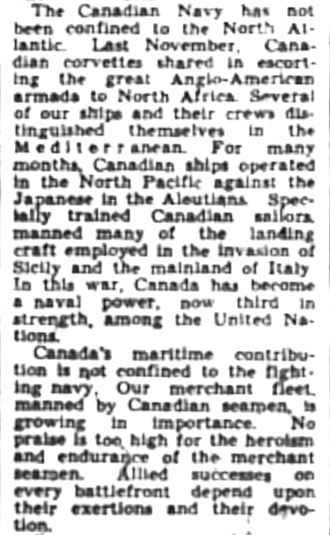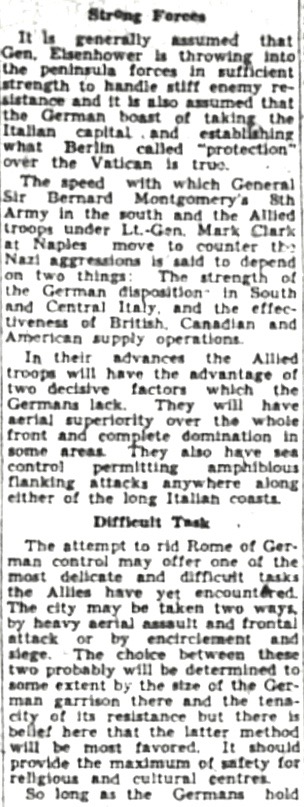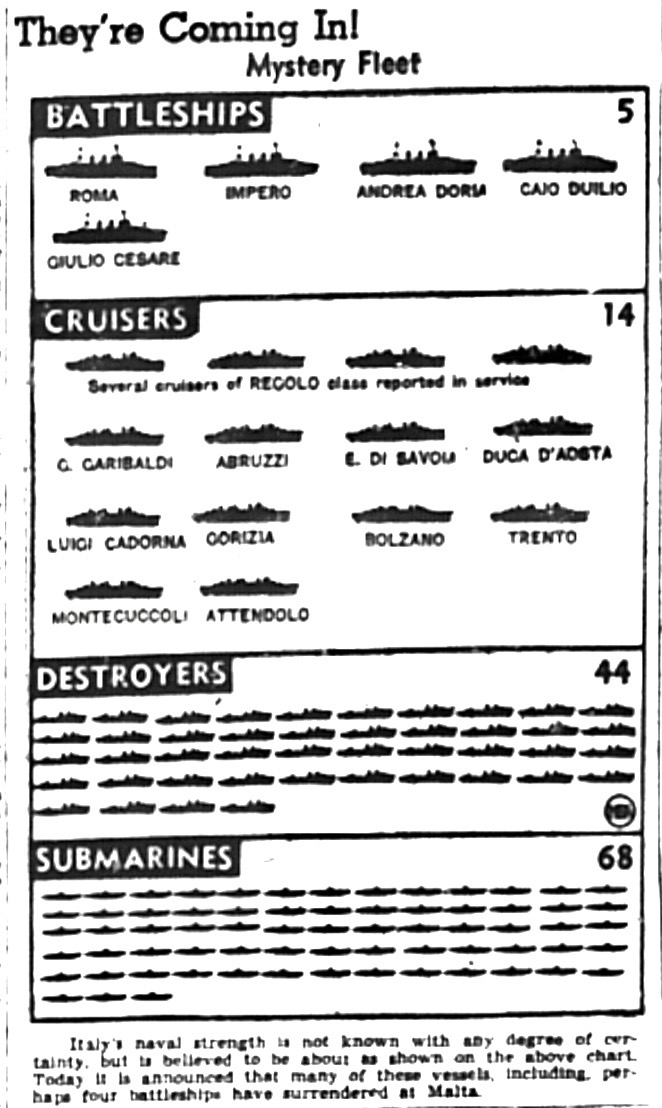Some Significant Details re Canadians in Combined Ops
Yes, I did say 'significant details' but my message did not relate the finding of Sholto Watt (reporter for The Montreal Star) or an article about him coming to shore in Reggio on an LCM manned by my father. I wish it was so. (So do some readers, I'm sure. Then this series could be shortened : )
That being said, in this September 11 issue of The Star I did come across two significant references to members of RCNVR who, like my father, manned landing crafts during the Dieppe Raid (Aug. '42) and subsequent invasions of North Africa (Nov. '42), Sicily and Italy (July and Sept. '43 respectively).
The first mention is in a lengthy article entitled "Canadian Navy Soon to Enter 'BIG SHIP' Field" which is found several articles below. The informative snippet I share next from that article reveals 3 numbers that do not appear often, as far as I know.
The seldom-seen numbers are:
a) "70,000 all ranks" in the RCN (most of which would be made up of members of RCNVR.
b) "3,700 women," perhaps chiefly referring to volunteers in Women's Royal Canadian Naval Service (WRCNS) and other navy organizations.
c) "1,000 Canadian naval ratings" that would eventually be trained to operate landing crafts, some of which (500) assisted the Allied landings in Sicily.
The reference to Canada's connection to Combined Operations is rare (unless you visit the site regularly) as is the note about how many Canadians in Comb. Ops were in action In Sicily and Italy. They were on loan to the Royal Navy, temporarily I would say, by way of a generous offer (or agreement) from the Canadian government to the British government.
The earliest reference to Canada's offer of officers and ratings from the RCN or RCNVR to assist with operations planned by Great Britain's Combined Operations organization can be found in The Watery Maze by B. Fergusson where we read the following:
About an eventual Channel crossing and the D-Day assault -
"Obviously two of the most urgent problems were the provision of landing ships and craft, and the crews to man them... And where were the crews to come from? Canada made an offer, which was gratefully accepted, of 50 officers and 300 ratings, but this was a drop in the bucket." (Page 93)
The first draft of about 50 Canadian ratings volunteered (and were thereby released temporarily into the loving care of the Combined Ops organization) in December 1941, approx., and a second draft of about the same number volunteered shortly thereafter. Together, the two drafts left for the UK aboard the Volendam, a Dutch liner, in late January, 1942.
Their first actions were the Dieppe Raid, Operation Jubilee (Aug. '42) and the invasion of North Africa, Operation Torch (Nov. '42):
Canadians manned ALCs and LCMs during Operation Torch. Above, US troops
unload their gear as a Canadian sailor handles the anti-broaching line (far left).
That is the first reference I have seen re "1,000 ratings" other than in my father's memoirs. Another vet's memoirs mentions 950 total ratings in Comb. Ops. I do not know how many were available for Dieppe or North Africa but I have read a mention of 500 ratings in Sicily (Operation Husky) in articles published by The Winnipeg Tribune (July '43). Those articles were posted earlier on this blog/website.
As well, I am happy to contribute more articles that feature some recognition and praise for the many branches of the Canadian Navy (e.g., "Specially trained Canadian sailors manned many of the landing craft employed in the invasion of Sicily and the mainland of Italy.") some of which is seen below. The full article follows later on in this day's post:
This report includes items from nazi News sources and not all details are correct. Later news will likely straighten out the actions attributed to Premier Badoglio and Benito Mussolini:
U.S. and British troops landed in various locations during the first week or two of September. Some landings were easy, others were extremely difficult. The landing described below makes life in Italy look easy. Matters will change!
Not only was there a bitter battle for landing and establishing a beachhead near Salerno and Naples (250-plus miles north from the easier, initial landings at Reggio di Calabria (toe of the boot), but the future fight for Rome was also predicted to be tough, and rightly so.
Nazi leadership ruled with an iron fist, while they could:
The Red Army was enjoying new-found momentum along the Eastern front:
As Allied forces landed near Naples, the threat of harm from the Italian navy was reduced to nil as one will read below, in an article that covers more ground than some of the American or British troops at the time:
For military strategists, news that German divisions had to be removed from the Russian front, is positive... for the Russians:
With Christmas coming, the public is given a lot of instruction re "mailing stuff early" and in the right type of packaging:
The earlier the better... and more:
On a side note, I have been searching for a surviving family member of wireless operator Don Fillmore of Stellarton, Nova Scotia, a man who landed in Reggio with members of the 80th Flotilla of Canadian landing crafts. I have had some good luck collecting Mr. Fillmore's obituary with mention of family members who were alive at the time of his death (1996 if memory serves). But further steps have proven more difficult.
Here is a good photo from a researcher's point of view. Lots of names, lots of partial addresses:
In this article we find the numbers re the members of the RCN (and RCNVR and Combined Operations) who were active in landings in Sicily, along w more information about the positive growth and stature of the Canadian Navy in general:
The RCN would grow to include approx 100,000 members during WW2, with 90 - 95 % of those choosing the RCNVR, volunteer reserve. And of those, about 1% would volunteer for Combined Operations and serve aboard landing crafts:
So, the Navy would grow by another 30,000 over the next two years and a good percentage would be women.
I find it interesting that in point 5 we read, "1,000 ratings will be used in Commando landing craft." There were Commando units involved in various places during WW2, surely at Sicily and Italy if memory serves, but Canadians in Combined Ops did not work exclusively with Commando units or even most of the time. They landed American and British troops in North Africa, and British and Americans in Sicily, and Canadian, British and American troops in Italy. As well, there would have been quite a few less helping out in Italy because three of four Canadian Flotillas of Landing Craft (55th, 61st and 81st Flotillas) were not used in Italy, only the 80th:
More details about the Canadian Navy continue:
I have mentioned briefly the praise for the armed forces found within the following speech made by Canada's Premier or Prime Minister. A lengthy description follows re the role of Canadians on many fronts and operations.
E.g., Courage Lauded -
In fighting on land, Hong Kong and Dieppe showed the world, what every Canadian knew in his heart, that Canadian soldiers of today have all the courage and all the spirit their fathers displayed on the fields of France and Flanders.
And members of the Navy and Air Force did no less:
When I see something about Mountbatten, head of Combined Operations when the Dieppe Raid was planned, I realize not all of my thoughts of him are positive:
Though the author is reminded of "amateur sailors... a cross-section of the youthful population of the British Isles," much of the information shared relates also to 1,000 young Canadians who volunteered for RCNVR, had "Hostilities Only" typed into their records (they would serve only to the end of hostilities, or to the end of the war) and became members of Combined Operations "under Lord Louis Mountbatten" as seen below:
I think the last paragraph (above) of Sir A. Hurd's opinions raises a good question, i.e., "How should we treat them (the 'amateur sailors' from Britain, Canada, etc.) when they - having survived the war - return to their homes?"
I think many were treated well, many were not. Many went back to work, quietly. Many could not. The full story may never be written about their return, both good and bad.
Note to self: Look for Hurd's other two essays mentioned off the top.
From 7 cents for Tru-Orange, to 1,000 Canadians in Combined Ops to $24 billion in war profits. This post covers a lot of numbers:
Need a break? Save up your nickels and go see "Meet the Navy."
Now we are.
Please link to Invasion of Italy (8) - Montreal Star (Sept. 9-10 '43)
Unattributed Photos GH






























































No comments:
Post a Comment